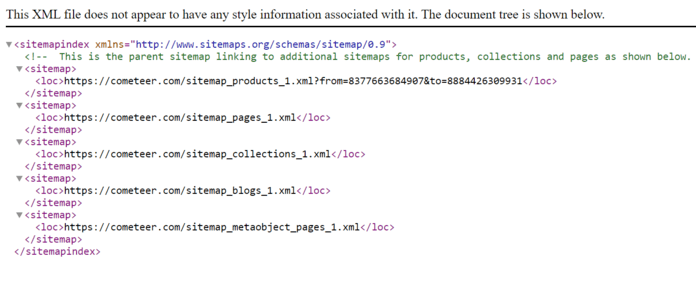Have you ever gotten turned around at a theme park or in a museum? It can be tricky to figure out where you are, where you’ve already been, and how to get where you want to go.
It’s kind of similar online. Websites typically have a lot of different pages, and if there’s not a clear layout to those pages, users can quickly get lost. Poor navigation can be a reason why a website isn’t making money. That’s why we have things like navigation bars. But while that might be enough for users, Google’s crawlers need more than that.
So, what do you do when you’re lost in a theme park? Odds are, you get ahold of a map. As it happens, that’s the same thing Google needs to properly crawl your website: A sitemap. A sitemap can significantly improve your search engine optimization (SEO) by helping Google crawl the right pages.
But what is a sitemap, and how can it improve your SEO? That’s what we’re here to discuss. Below, we’ll cover the following topics:
- What are sitemaps?
- Why use sitemaps for SEO?
- XML sitemaps vs. HTML sitemaps
- How can you create a sitemap?
- How can you submit your sitemap to Google?
Keep reading to find out more about the benefits of sitemaps for SEO!
What are sitemaps?

A sitemap is every bit what it sounds like: A map of your website. To be more specific, though, a sitemap is a file that lays out all the pages and content across your website and shows how those elements are connected. The idea is to provide a full layout of the structure of your site.
Why use sitemaps for SEO?
So, what’s the use of sitemaps? How do they benefit your business?

“Create an XML sitemap file to ensure that search engines discover the new and updated pages on your site, listing all relevant URLs together with their primary content’s last modified dates.”
The answer is that they’re vital to getting all of your pages indexed by Google. The thing is, without a sitemap, Google will have no idea which pages are part of your website or how those pages are connected. But when you submit a sitemap, it can easily see which pages to index.
XML sitemaps vs. HTML sitemaps
There are two main types of sitemaps: XML sitemaps and HTML sitemaps.
HTML sitemaps
An HTML sitemap is designed for users. It appears as a visible component of your website, usually in the form of a sidebar or navigation bar. When we talk about sitemaps in an SEO context, this usually isn’t the type of sitemap we mean (although it’s definitely an essential website component).
XML sitemaps
More often, the word “sitemap” refers to an XML sitemap. This is the type of sitemap we defined above — the kind designed for Google crawlers. Unlike an HTML sitemap, it isn’t displayed on the user-facing part of your website. Instead, it’s submitted to Google directly.
How can you create a sitemap?
So, how can you actually make an XML sitemap?
If your website is built using a content management system (CMS), there’s a good chance you already have one.
Many CMS platforms automatically generate sitemaps for your website, so you may not have to do any work at all. Of course, even if that’s the case, you may want to build your own sitemap anyway if there are specific pages you don’t want to include in it.
Luckily, many CMS platforms also allow you to create a sitemap through the tool. HubSpot is an example of a CMS that does this — it features a sitemap builder and editor that you can use to put a sitemap together with ease.
You can also create one from scratch, of course. To do this, though, you’ll need to have some level of XML knowledge. If you have that knowledge, though, it’s simply a matter of deciding which pages to include in the sitemap and then coding all of those URLs into XML tags.
How can you submit your sitemap to Google?
There are multiple ways to submit your sitemap to Google. However, the easiest method is to do it through Google Search Console.
To submit your sitemap, go to Search Console and follow these steps:
- Click on “Sitemap” in the left-hand sidebar.
- Under “Add a new sitemap,” type in the URL for your sitemap and hit “Submit.”
That’s it! It’s a two-step process — nothing else to it. Once you do this, Google will begin to crawl and index your website, which will allow your site to begin ranking in relevant search results. That, in turn, will give a massive boost to your SEO strategy.
Find out more ways to improve your SEO here on SEO.com
A sitemap is essential for any company’s SEO strategy. But it’s far from the only important SEO tactic. If you want to learn more about what you can do to boost your search rankings, traffic, and conversions, you’re in the right place. Check out some other helpful pages here on SEO.com!
Let’s Drive Results Together 
Writers

Related Resources
- SEO & Fonts: Do Fonts Affect SEO? (And How to Optimize Yours)
- SEO vs. UX: How to Bring Them Together for Higher Rankings
- Subdomains for SEO: Should You Use Them? Why & Why Not
- The 2024 SEO Checklist for Website Redesigns
- What Happens if You’re the Target of an SEO Attack?
- What is a Robots.txt File and Why is It Important?
- What is Page Speed SEO, and How Can You Optimize for It?
- What is Schema Markup? + How to Implement It for SEO
- What is Website Security and How Can You Optimize for It?
- 9 Website Accessibility Best Practices You Can Emulate

